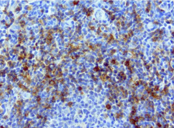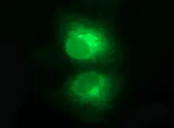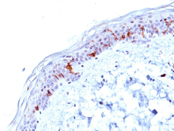CD1C: A Dendritic Cell Surface Marker that Induces T-Cell Response
CD1C belongs to the CD1 family that plays roles in adaptive immunity, tissue homeostasis,and autoimmune diseases. Like MHC class I molecules (MHC-I), CD1 proteins form heterodimers with β2-macroglobulin (B2M) and present lipid antigens on the cell surface to interact with T cells. Human CD1 proteins (CD1A, CD1B, CD1C, CD1D, and CD1E) have different structural frameworks in their ligand-binding pockets, which may result in their different preference for bound lipids. For example, the anti-tumor immunostimulant α-galactosylceramide (α-GalCer) binds CD1D, whereas the cancer lipid antigen methyl-lysophosphatidic acid (LPA) binds CD1C. In addition, CD1 isotypes distribute differently in the cellular endomembrane system.
OriGene offers a range of tools for analyzing CD1 family. Click the box for details.




CD1 Family
CD1A CD1B CD1C CD1D CD1EDendritic Cell Marker
CD163 CD1C CD5 CD2 CD14 CLEC4C CLEC9A BTLA THBD XCR1Immune Checkpoint Protein
CD47 PDCD1 CD274 LILRB1 CD24 SIGLEC10 And More…Surface CD1 proteins engaged by unconventional T cells
TCRS in unconventional T-cells can recognize loaded CD1 on the cell surface. Unconventional T-cells include a compartment of T cell subsets that recognize various non-classical MHC molecules such as CD1 and HLA-E. This group of T cells has developmental patterns different from conventional T cells, such as their early presence in life, the restricted TCR profile (against monomorphic ligands), high frequency in local tissues, and memory-like T cell state (ready for cytokine secretion). Due to these respects, unconventional T cells and their corresponding CD1 ligands, like natural killer T cells (NKT) and CD1D, have been targeted in various clinical trials, including CAR T-cell cancer therapies.
CD1C: A defining marker for dendritic cell subsets
CD1C is widely localized throughout the endocytic system and the plasma membrane of the antigen-presenting cells. CD1C is expressed on the surface of B cells in lymph nodes, spleen, and blood. CD1C expression can also be induced in activated monocytes. Furthermore, CD1C is a defined marker of subsets of conventional dendritic cells (cDC2 and cDC3). cDC2 are recently found able to prime CD4+ effector T cells to infiltrate tumors and may serve as a prognostic indicator for survival and response to immune checkpoint anti-PD-1 therapy, which makes CD1C a hot topic in cancer research.
References
- Sugita et al. 2000 Jul 18. doi: 10.1073/pnas.150236797
- Godfrey et al. 2018 Mar. doi: 10.1016/j.immuni.2018.03.009
- Wun et al. 2018 Apr. doi: 10.1038/s41590-018-0065-7
- Binnewies et al. 2019 Apr. doi: 10.1016/j.cell.2019.02.005
- D'Souza et al. 2019 Feb. doi: 10.1371/journal.ppat.1007567
- Mayassi et al. 2021 Jul. doi: 10.1038/s41586-021-03578-0






























































































































































































































































 Germany
Germany
 Japan
Japan
 United Kingdom
United Kingdom
 China
China